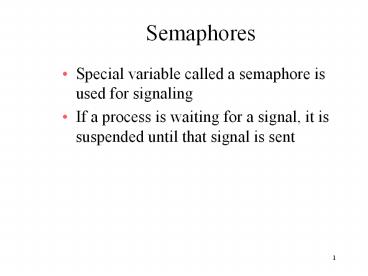Semaphores - PowerPoint PPT Presentation
Title:
Semaphores
Description:
Title: Concurrency: Mutual Exclusion and Synchronization Author: Patricia Roy Last modified by: Shieuhong Lin Created Date: 6/26/1999 9:48:38 PM Document presentation ... – PowerPoint PPT presentation
Number of Views:119
Avg rating:3.0/5.0
Title: Semaphores
1
Semaphores
- Special variable called a semaphore is used for
signaling - If a process is waiting for a signal, it is
suspended until that signal is sent
2
Semaphores
- Semaphore is a variable that has an integer value
- May be initialized to a nonnegative number
- Wait operation decrements the semaphore value
- Signal operation increments semaphore value
3
Semaphore Primitives
4
Mutual Exclusion Using Semaphores
5
(No Transcript)
6
(No Transcript)
7
Producer/Consumer Problem
- One or more producers are generating data and
placing these in a buffer - A single consumer is taking items out of the
buffer one at time - Only one producer or consumer may access the
buffer at any one time
8
Producer
- producer
- while (true)
- / produce item v /
- bin v
- in
9
Consumer
- consumer
- while (true)
- while (in lt out)
- /do nothing /
- w bout
- out
- / consume item w /
10
Producer/Consumer Problem
11
Producer with Circular Buffer
- producer
- while (true)
- / produce item v /
- while ((in 1) n out) / do nothing /
- bin v
- in (in 1) n
12
Consumer with Circular Buffer
- consumer
- while (true)
- while (in out)
- / do nothing /
- w bout
- out (out 1) n
- / consume item w /
13
(No Transcript)
14
(No Transcript)
15
(No Transcript)
16
(No Transcript)
17
(No Transcript)
18
Monitors
- Monitor is a software module
- Chief characteristics
- Local data variables are accessible only by the
monitor - Process enters monitor by invoking one of its
procedures - Only one process may be executing in the monitor
at a time
19
(No Transcript)
20
(No Transcript)
21
(No Transcript)
22
(No Transcript)
23
Message Passing
- Enforce mutual exclusion
- Exchange information
- send (destination, message)
- receive (source, message)
24
Synchronization
- Sender and receiver may or may not be blocking
(waiting for message) - Blocking send, blocking receive
- Both sender and receiver are blocked until
message is delivered - Called a rendezvous
25
Synchronization
- Nonblocking send, blocking receive
- Sender continues on
- Receiver is blocked until the requested message
arrives - Nonblocking send, nonblocking receive
- Neither party is required to wait
26
Addressing
- Direct addressing
- Send primitive includes a specific identifier of
the destination process - Receive primitive could know ahead of time which
process a message is expected - Receive primitive could use source parameter to
return a value when the receive operation has
been performed
27
Addressing
- Indirect addressing
- Messages are sent to a shared data structure
consisting of queues - Queues are called mailboxes
- One process sends a message to the mailbox and
the other process picks up the message from the
mailbox
28
(No Transcript)
29
Message Format
30
(No Transcript)
31
(No Transcript)
32
Readers/Writers Problem
- Any number of readers may simultaneously read the
file - Only one writer at a time may write to the file
- If a writer is writing to the file, no reader may
read it
33
(No Transcript)
34
(No Transcript)































